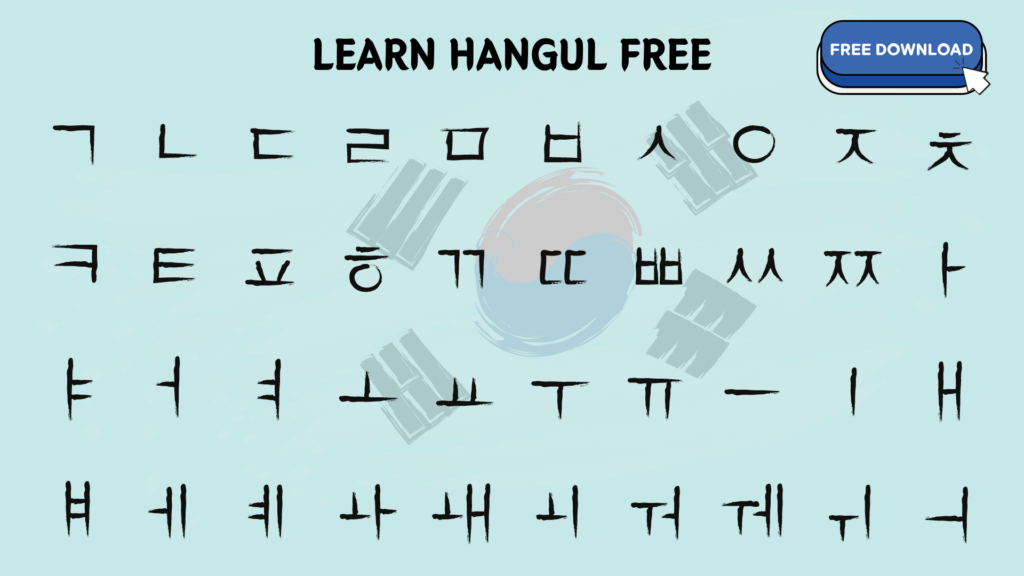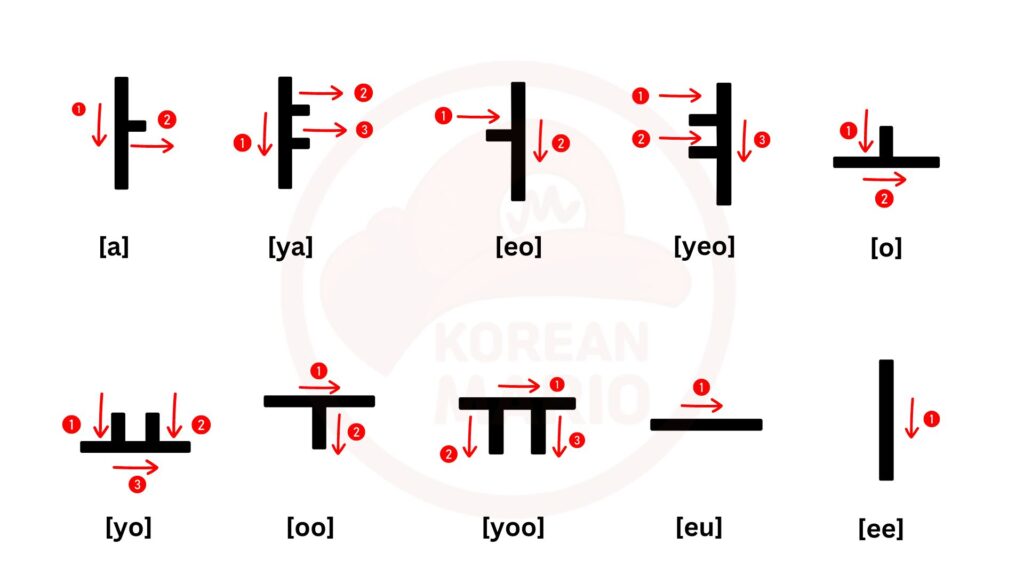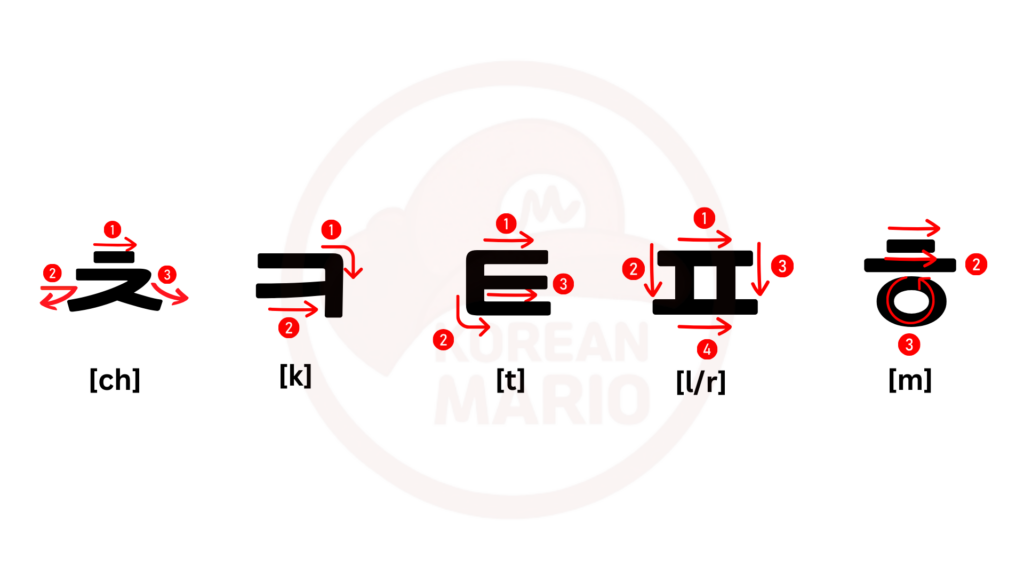
History of Hangul
Hangul is the native alphabet of the Korean language. It was created in the 15th century under the rule of King Sejong the Great of the Joseon Dynasty. Hangul is unique in that it was intentionally designed to be easy to learn and use, with each letter representing a distinct sound. It consists of 24 letters: 14 consonants and 10 vowels.
Hangul has played a significant role in promoting literacy in Korea and is considered one of the most scientific writing systems in the world.
Consonants vs. Vowels
In Hangul, the Korean alphabet, there are both consonants and vowels.

Consonants: These are the basic building blocks of Korean words. They represent the sounds made by obstructing or partially obstructing the airflow through the mouth. Hangul has 14 consonants. Some examples include ㄱ (g/k), ㄴ (n), ㄷ (d/t), ㄹ (r/l), and ㅁ (m).
Vowels: These are sounds produced without any obstruction of the airflow, usually made with an open vocal tract. Hangul has 10 vowels. Some examples include ㅏ (a), ㅓ (eo), ㅗ (o), ㅜ (u), and ㅣ (i).
These consonants and vowels combine to form syllabic blocks, which make up Korean words. The simplicity and phonetic nature of Hangul make it relatively easy to learn compared to other writing systems.
5 Ways to Form a Hangul
In Hangul, consonants and vowels are combined to form syllabic blocks, which then create words. Here’s how it works:

Vowels
Basic Vowels
These are sounds produced without any obstruction of the airflow, usually made with an open vocal tract. Hangul has 10 vowels. Some examples include ㅏ (a), ㅓ (eo), ㅗ (o), ㅜ (u), and ㅣ (i).
How To Write

Compound Vowels
Consonants
Single Consonants
These are the basic building blocks of Korean words. They represent the sounds made by obstructing or partially obstructing the airflow through the mouth.
How To Write

Aspirated Consonants
Aspirated consonants are a feature of many languages, including Korean. In phonetics, aspiration refers to the burst of air that accompanies the release of certain consonants. In Korean, there are three aspirated consonants: ㅍ (p’), ㅌ (t’), and ㅋ (k’).
These consonants are similar to their unaspirated counterparts (ㄱ, ㄷ, and ㅂ, respectively) but are pronounced with a stronger burst of air. For example, the aspirated consonant ㅍ (p’) is pronounced with a puff of air, as in the word “포도” (podo), meaning “grape.”
Understanding the difference between aspirated and unaspirated consonants is important for correct pronunciation in Korean, as it can change the meaning of words.
For example, compare the following pairs of words:
- “pat” (aspirated) vs. “bat” (unaspirated)
- “top” (aspirated) vs. “stop” (unaspirated)
- “kit” (aspirated) vs. “skit” (unaspirated)
In Korean, we have 5 aspirated consonants:
How To Write

Double Consonants
Pronunciation Practice 1
Listen to the audio guide repeatedly and aim to memorize all the content without relying on the Romanization. While Korean alphabets may sound similar to English, they are not identical. Focus on my pronunciation and engage in extensive practice sessions.
| 🔉 | 가 | 갸 | 거 | 겨 | 고 | 교 | 구 | 규 | 그 | 기 |
| 🔉 | 나 | 냐 | 너 | 녀 | 노 | 뇨 | 누 | 뉴 | 느 | 니 |
| 🔉 | 다 | 댜 | 더 | 뎌 | 도 | 됴 | 두 | 듀 | 드 | 디 |
| 🔉 | 라 | 랴 | 러 | 려 | 로 | 료 | 루 | 류 | 르 | 리 |
| 🔉 | 마 | 먀 | 머 | 며 | 모 | 묘 | 무 | 뮤 | 므 | 미 |
| 🔉 | 바 | 뱌 | 버 | 벼 | 보 | 뵤 | 부 | 뷰 | 브 | 비 |
| 🔉 | 사 | 샤 | 서 | 셔 | 소 | 쇼 | 수 | 슈 | 스 | 시 |
| 🔉 | 아 | 야 | 어 | 여 | 오 | 요 | 우 | 유 | 으 | 이 |
| 🔉 | 자 | 쟈 | 저 | 져 | 조 | 죠 | 주 | 쥬 | 즈 | 지 |
| 🔉 | 차 | 챠 | 처 | 쳐 | 초 | 쵸 | 추 | 츄 | 츠 | 치 |
| 🔉 | 카 | 캬 | 커 | 켜 | 코 | 쿄 | 쿠 | 큐 | 크 | 키 |
| 🔉 | 타 | 탸 | 터 | 텨 | 토 | 툐 | 투 | 튜 | 트 | 티 |
| 🔉 | 파 | 퍄 | 퍼 | 펴 | 포 | 표 | 푸 | 퓨 | 프 | 피 |
| 🔉 | 하 | 햐 | 혀 | 혀 | 호 | 효 | 후 | 휴 | 흐 | 히 |
Pronunciation Practice 2
Listen to the audio guide repeatedly and aim to memorize all the content without relying on the Romanization. While Korean alphabets may sound similar to English, they are not identical. Focus on my pronunciation and engage in extensive practice sessions.
Pronunciation Practice 3
Pay close attention to the differences, as incorrect pronunciation can alter the meaning of words.
Final Consonants (Batchim)
Final consonants, also known as batchim (받침) in Korean, refer to consonants that appear at the end of a syllable block. In Hangul, these final consonants are written below the main consonant-vowel combination.


Batchim Sound Rules
Pronunciation Practice 4
Listen to the audio guide repeatedly and aim to memorize all the content without relying on the Romanization. While Korean alphabets may sound similar to English, they are not identical. Focus on my pronunciation and engage in extensive practice sessions.

book
책 [chaeg]

kitchen
부억 [bu oeg]

outside
밖 [bag]

eyes
눈 [nun]

mountain
산 [san]

letter
편지 [pyeon ji]

horse
말 [mal]

face
얼굴 [eol gul]

water
물 [mul]

three
삼 [sam]

man
남자 [nam ja]

snake
뱀 [baem]

rice
밥 [bab]

cup
컵 [keob]

leaf
잎 [ib]

river
강 [gang]

bread
빵 [bbang]

bottle
병 [byeong]

clothes
옷 [od]

flower
꽃 [ggod]

red bean
팥 [pad]

to find
찾다 [chad da]

to put
놓다 [nod ta]

to have
있다 [id da]
Free PDF Download
To sum up, learning Korean alphabets is important. Even though some letters might look like English ones, they sound different. Practice is key to understanding these differences and avoiding confusion when speaking or listening.
Table of Contents


